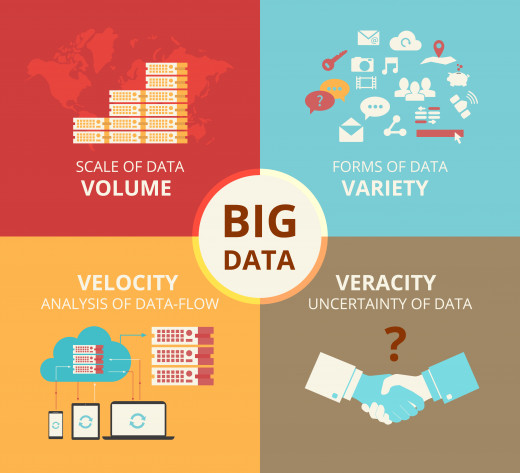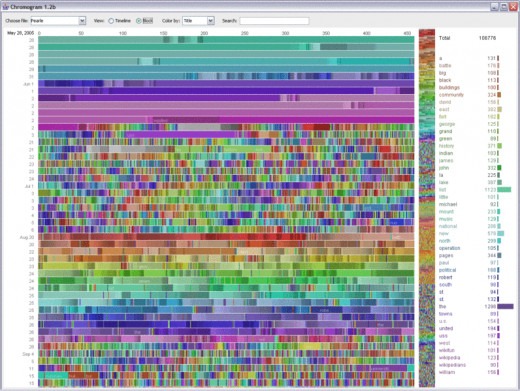Big Data Enters the Classroom
Conversation within education communities, secondary through to university, is abuzz with the topic of ‘big data’. The concept is attracting proponents, opponents and cautious optimism. But what is this entity that is generating so much excitement?
Big Data - Mapping the Future

What is ‘Big Data?’
In a Forbes article introducing this topic last year, big data was defined as “a collection of data from traditional and digital sources inside and outside your company that represents a source for ongoing discovery and analysis”. This gigantic collection is formed by the huge amounts of data that are streaming in by the second from an ever increasing variety of sources: financial transactions, emails, social media, online purchasing, traditional database collections, RFID and other electronic sensors. In the past, all this data was too complex, too large and too dynamic for conventional information processing methods to handle and unpack. But now, with breakthroughs in data processing technologies, big data can be analyzed and used by a multitude of sectors including retail, healthcare, government, and education, to improve the delivery of services.
Big Data: Implications for the Future
A recent McKinsey article characterizes big data as the next frontier in the world of innovation. The authors suggest that virtually immeasurable data bits from sources such as Google search, phone records and online purchases, combined with massive computer manipulation, can solve practically every problem in the world—crunch the numbers and you arrive at a solution. In Patrick Tucker’s ‘Naked Future’, he writes that big data provides the fodder to predict with almost precision-point accuracy the future of practically every area of human existence, even those that appeared to be beyond prediction.
McKinsey Business Technology Office and MGI researchers examined the implications of big data in five sectors: retail and healthcare in the United States, the public sector in Europe, and manufacturing and personal-location data around the globe. They found, among other things, that retailers could increase their profit margin by more than 60% by fully utilizing big data information. The US healthcare industry could create at least $300 billion in value every two years simply by using big data efficiently and creatively.
Big data also calls for more professionals with the analytical skills necessary to fully understand, assess, manipulate and present the outcomes in a way that is useful to strategic planning and effective decision-making. The McKinsey article projected a shortage of 140,000-190,000 qualified professionals in the US alone. Big data therefore has far-reaching implications for training and professional development.

Big Data in the Classroom
Big data in its basic sense is not new to education, and hours of classroom interaction, testing and homework have always generated significant insights. And interactions between teachers and students can now yield countless ‘digital clues’ to learning style, effectiveness of course materials and delivery, impacts of learning environments and so forth ─ all of which can be easily collected, tracked and disseminated through social networks, learning management systems and other electronic outlets. However, big data also comes with big risks and ethical challenges that must be fully vetted in order to make it an accepted tool within the education sector.
Big data was a hot topic at the 2013 World Innovation Summit for Education attended by educators, policymakers and government officials from more than 100 countries. While discussing the immense and pressing need for radical innovations in education delivery, big data seemed to generate a buzz of optimism among participants. In an Innovation Excellence Weekly post on the summit, several recommendations are given to education professionals as to how to make the best use of big data while avoiding the pitfalls: transparency, privacy, making it valuable to the learner, moving beyond superficial measurements, laying out the expenditure, broadening the view of relevant data, and presenting data results in a strategic way so they can bring about infrastructure change.
A White House report on big data published in May this year, notes that students now access educational instruction and materials through a large range of technologies intended to improve their learning experience. For example, students are watching videos, taking classes online, completing homework and tests online, and interacting with their teachers and peers online. All of these technologies are producing a plethora of data sets that can be analyzed to improve course delivery and educational materials to increase student performance.
Kenneth Cukier: Big Data is Better Data

The Big Verdict?
The presence of big data is not going diminish. There is a consensus that it holds invaluable keys to understanding how education is impacting students and how education delivery can be improved, and the outstanding issues of accessibility and utilization will continue to be addressed by the leaders in the industry. Through innovative courses such as Harvard’s Data Science in Education, educators should be prepared to unlock and utilize the tightly potential learning that big data holds, and bring about ever higher standards of education delivery to classrooms across the globe.
Teaching Big Data
In order to address some of the challenges mentioned above, Harvard has created a new learning program entitled ‘Data Science in Education: Learning Analytics and the Information Age’. The course is intended to present the basics of big data to the educators and social innovators of the future, focusing on the uses of big data in education and preparing students to be critical users of big data analyses ─ especially as they continue to proliferate and drive innovation and educational delivery and technology. Students will learn about the methodologies and technologies of data science, how education big data is mined, and will discuss the impacts and potential for educational advancement that big data driven-innovation presents. They will gain hands-on experience in data analysis methodologies and its application to the challenges of education. The course will focus on the three main subject areas associated with big data: Educational Mining Data, Data Science and Learning Analytics. With a strong understanding of how statistics, computer science and education have intersected to produce new teaching and product development, students will emerge better equipped to assess and potentially become involved in utilizing this new field to develop product for classroom instruction.
Columbia University’s Teachers College is offering a new Massive Online Open Textbook course (MOOT) called ‘Big Data in Education’. Columbia acknowledges that online education and software are tools that are here to stay when it comes to the delivery of education to a broad range of students in locations far and wide. The course prepares students to engage in educational data mining and analytics, concentrating on methodologies for accumulation and analysis. The topics covered include prediction modelling, relationship mining, the visualization of educational data and education databases. The course is presented over a period of eight weeks, through video, homework assignments and quizzes.
Learn More about Big Data
* According to Wikipedia, big data "is an all-encompassing term for any collection of data sets so large and complex that it becomes difficult to process using traditional data processing applications".
Learn more about the subject on Wikipedia's entry about big data.



